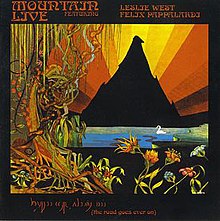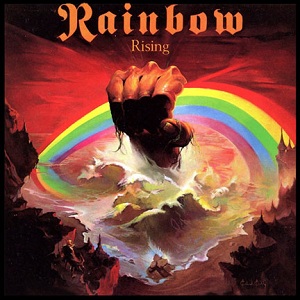 Yes, The Road Goes Ever On is an actual album title. It’s a Mountain live album from 1971. It’s bluesy, warm, and amazing. Leslie West, the band leader and guitarist, has been described as “a guitar player’s guitar player.” Although obscure outside of the band’s big single, “Mississippi Queen,” West is a master guitarist that has garnered the recognition of the best in the business.
Yes, The Road Goes Ever On is an actual album title. It’s a Mountain live album from 1971. It’s bluesy, warm, and amazing. Leslie West, the band leader and guitarist, has been described as “a guitar player’s guitar player.” Although obscure outside of the band’s big single, “Mississippi Queen,” West is a master guitarist that has garnered the recognition of the best in the business.
This album has but four tracks. The first two, “Long Red” and “Waiting to Take You Away,” were from the band’s appearance at Woodstock in 1969. “Long Red” is a nice blues-based jam, while “Waiting to Take You Away” is a dreamy, impassioned exploration. Side one finishes off with “Crossroader,” another blues song that comes right out of Cream’s playbook. Ironically, the band’s producer and bassist, Felix Pappalardi, hated comparisons between Mountain and Cream and took pains to show how they were different, even though his vocal style was very much like Jack Bruce’s. All through side one, West’s guitar solos are a real treat. It’s fun stuff.
Side two is one song: “Nantucket Sleighride.” Over seventeen minutes of jamming and sonic power. It takes the dreamscapes of “Waiting to Take You Away” and develops them at length. While I truly enjoy the studio version of the song, I always enjoy the live versions of the song. West’s ability to improvise with brilliance never disappoints. The keyboard player, Steve Knight, is a bit uninspired, but Corky Laing’s drumming and Pappalardi’s thunderous bass playing more than make up for Knight’s shortcomings. In the end, it’s West’s guitar and the visions that spring from it that dominate the album.
If the album was just “Nantucket Sleighride,” I’d give it a 10. There are a few hitches and glitches on side one, but not enough to make the album score less than a 9 out of 10. It’s well worth finding. The live version of “Nantucket Sleighride” is a 99-cent download from Amazon, and that makes it a steal at that price.
 Let It Bleed stands as a critics’ favorite among the Stones’ catalog. For me, it will always be a huge disappointment.
Let It Bleed stands as a critics’ favorite among the Stones’ catalog. For me, it will always be a huge disappointment. Yes, The Road Goes Ever On is an actual album title. It’s a Mountain live album from 1971. It’s bluesy, warm, and amazing. Leslie West, the band leader and guitarist, has been described as “a guitar player’s guitar player.” Although obscure outside of the band’s big single, “Mississippi Queen,” West is a master guitarist that has garnered the recognition of the best in the business.
Yes, The Road Goes Ever On is an actual album title. It’s a Mountain live album from 1971. It’s bluesy, warm, and amazing. Leslie West, the band leader and guitarist, has been described as “a guitar player’s guitar player.” Although obscure outside of the band’s big single, “Mississippi Queen,” West is a master guitarist that has garnered the recognition of the best in the business. NOTE TO THE WORLD: I have decided to secede from the ancient confines of traditional astrology, based upon Babylonian noodlings about the stars. It’s fatalistic, shoving people into their places based upon their time of birth, giving rise to notions of legitimacy based solely upon that factor and ruling out any possibility of a merit-based system. Such a system offends my modern sensibilities, and I won’t be party to it.
NOTE TO THE WORLD: I have decided to secede from the ancient confines of traditional astrology, based upon Babylonian noodlings about the stars. It’s fatalistic, shoving people into their places based upon their time of birth, giving rise to notions of legitimacy based solely upon that factor and ruling out any possibility of a merit-based system. Such a system offends my modern sensibilities, and I won’t be party to it. Rule number one: In my van, it’s Rush. All Rush, all the time. No exceptions.
Rule number one: In my van, it’s Rush. All Rush, all the time. No exceptions. The Devdas soundtrack is a rich treasure trove of Bollywood music. The movie is fantastic, and the music is a huge part of that fantasticness. The climax of the film, built around the song “Dola Re Dola”, is also the climax of the soundtrack. It won a boatload of awards, and deservedly so. It wins my award of “Favoritest Bollywood Song Evar!!!!”
The Devdas soundtrack is a rich treasure trove of Bollywood music. The movie is fantastic, and the music is a huge part of that fantasticness. The climax of the film, built around the song “Dola Re Dola”, is also the climax of the soundtrack. It won a boatload of awards, and deservedly so. It wins my award of “Favoritest Bollywood Song Evar!!!!” I love reviewing this album any chance I can get. It’s one of my perfect 10’s and if you’re a fan of hard rock or metal, you must get this disc. It’s got Dio, Blackmore, and Cozy Powell at their prime with excellent turns from keyboardist Tony Carey and bassist Jimmy Bain. The band are tight, the music solid, and the virtuosity impeccable.
I love reviewing this album any chance I can get. It’s one of my perfect 10’s and if you’re a fan of hard rock or metal, you must get this disc. It’s got Dio, Blackmore, and Cozy Powell at their prime with excellent turns from keyboardist Tony Carey and bassist Jimmy Bain. The band are tight, the music solid, and the virtuosity impeccable. Monday, another day for disappointment in recordings… This week’s dirge deals with Ian Gillan Band’s Child in Time. The fact that I am NOT listening to any of its tracks as I write this is indicative of how poorly I think of it.
Monday, another day for disappointment in recordings… This week’s dirge deals with Ian Gillan Band’s Child in Time. The fact that I am NOT listening to any of its tracks as I write this is indicative of how poorly I think of it.